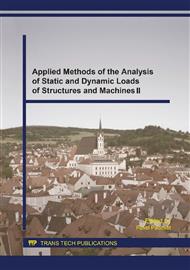[1]
J.A. Carneiro et al., Compressive stress-strain behavior of steel fiber reinforced-recycled aggregate concrete, Cement and concrete composites 46 (2014) 65-72.
DOI: 10.1016/j.cemconcomp.2013.11.006
Google Scholar
[2]
M.S. Meddah, M. Bencheikh, Properties of concrete reinforced with different kinds of industrial waste fibre materials, Constr. Build. Mater. 23 (10) (2009), 3196-3205.
DOI: 10.1016/j.conbuildmat.2009.06.017
Google Scholar
[3]
K. Seps, J. Vodicka, Fibre Reinforced Concrete with Recycled Concrete and Insulation Material STERED, Special Concrete and Composites 1054 (2014) 162-166.
DOI: 10.4028/www.scientific.net/amr.1054.262
Google Scholar
[4]
N. Banthia et al., Fiber synergy in Hybrid Fiber Reinforced Concrete (HyFRC) in flexure and direct shear, Cement and Concrete Composites 48 (2014) 91-97.
DOI: 10.1016/j.cemconcomp.2013.10.018
Google Scholar
[5]
M. Lidmila, L. Horníček, Recycled concrete as a substitution for natural crushed aggregate used in a sub-ballast layer of track bed, in: EURO-ŽEL 2011 Recent Challenges for European Railways, Brno, 2011, pp.401-407, ISBN 978-80-263-0003-8.
Google Scholar
[6]
M. Lidmila et al., Utilization of recycled fine-ground concrete from railway sleepers for production of cement-based binder, Applied Mechanics and Materials 486 (2014) 323-326.
DOI: 10.4028/www.scientific.net/amm.486.323
Google Scholar
[7]
H. Krejcirikova, M. Lidmila, Experimental and mathematical analysis of a multi-layer system of railway track, Komunikacie 6 (3) (2004) 44-46.
DOI: 10.26552/com.c.2004.3.44-46
Google Scholar
[8]
M. Lidmila et al., Utilization of recycled fine-ground concrete from railway sleepers for production of cement-based binder, Applied Mechanics and Materials 486 (2014) 323-326. doi: 10. 4028/www. scientific. net/AMM. 486. 323.
DOI: 10.4028/www.scientific.net/amm.486.323
Google Scholar
[9]
J. Topič et al., Effect of PVA Modification on the Properties of cement based composite, Acta Polytechnica 55 (1) (2015) 64-75.
Google Scholar
[10]
P. Padevet, P. Tesarek, T. Plachy, Evolution of mechanical properties of gypsum in time, International Journal of Mechanics 5 (2011) 1-9.
Google Scholar


